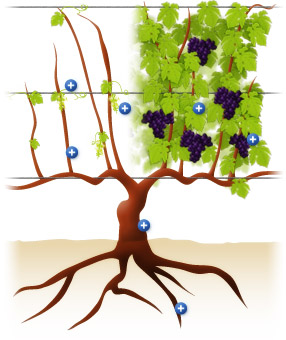 |
 |
 |
 |
 |
| For more information follow these links. |
|
 |
 |
 |
 |
|
 |
|
 |
The grapevine is a plant of the Vitaceae family. There are several species of vitaceae; however, the most used in quality wine plantations worldwide is the Vitis vinifera species.
 |
 |
 |
 |
Root
The root is the subterranean part of the grapevine. There are mainly two types of roots: the fine, tender ones that are found at the surface and get food for the plant, and the thicker, deeper, woody ones capable of anchoring the grapevine to the ground. |
 |
 |
 |
 |
 |
 |
 |
 |
Trunk
The part between the root and the first branches of the grapevine, the arms. The grapevine’s trunk is very fragile, so one uses props to support the plant. The props can be either living (trees: sweet chestnut, poplar or plane tree) or dead (wood, metal or cement sticks). |
 |
 |
 |
 |
 |
 |
 |
 |
Canes
The canes are the part of the grapevine that follows the arms (the first branches of the plant). This organ is also called stalk. |
 |
 |
 |
 |
 |
 |
 |
 |
Leaves
The leaves are made up of two distinct parts: the petiole (the slender part) and the blade (the wider, green part). It is through the ribs that the sap circulates in the leaves. |
 |
 |
 |
 |
 |
 |
 |
 |
Tendrils
Filamentous organ that is essential to the plant, since it allows the grapevine to cling to the props and stick the stalks, enabling them to rise. |
 |
 |
 |
 |
 |
 |
 |
 |
Flowers
The grapevine’s flowers are made up of calyx (androecium), corolla (gynoecium), stamens and pistil. The grapevine’s reproductive organs are the stamens – responsible for producing pollen – and the pistil – which, after being fertilised, produces the berries and seeds. |
 |
 |
 |
 |
 |
 |
 |
 |
Fruits
The grapevine’s fruits are the berries resulting from fertilisation of the flowers. The berry is made up of stem, pulp, seeds and skin. |
 |
 |
 |
 |
|
 |
|